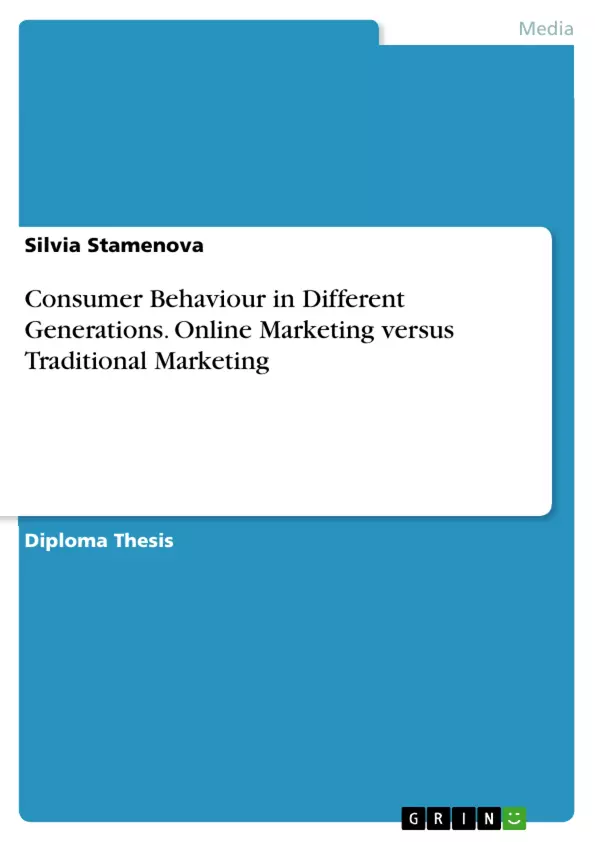The question posed in this thesis is this: what is the consumer behaviour in different generations? The examination of this question is imperative since recent literature has suggested that there is a great distinction between the behaviours of consumers of different generations. Unfortunately, such a statement, being regarded as too bold, is often ignored in the formulation of different marketing policies and strategies. This thesis, therefore, argues that as well as having different consumer behaviour in the different ages, the question of online marketing versus traditional one should also be considered. In other words, the potential of online marketing as a vehicle for scaling up the income of the modern industries should not lead to the traditional marketing being completely forgotten. This thesis explores this issue, as well as focuses on the consumer behaviour in different generations, how they look for products and what kind of value they regard as essential. Not only it relates to what marketing tools work for each generation but also to why some tools are perceived as wrong and some not. The project also focuses on gathering data on what different buyers prefer and what channels work best for each of them; in brief, the main focus of the research is to show how social media influences consumer behaviour and did it at all influences the older generations.
Inhaltsverzeichnis (Table of Contents)
- Acknowledgements
- Introduction
- Literature review
- Methodology
- Results/Analysis.
- Discussion
- Conclusions and Recommendations
- References
Zielsetzung und Themenschwerpunkte (Objectives and Key Themes)
This dissertation examines the consumer behavior of different generations in relation to online and traditional marketing methods. It aims to analyze how age, education, and income influence consumer preferences and to understand the effectiveness of different marketing tools across generations. The research focuses on Bulgarian customers aged 18 to 60 in Sofia and its surroundings. The study utilizes both qualitative and quantitative research methods, relying on surveys and online observations to gather data.
- The unique characteristics and consumer behavior of different generations
- The impact of online marketing versus traditional marketing on consumer behavior
- The influence of age, education, and income on consumer preferences
- The effectiveness of different marketing tools for different generations
- The importance of tailoring marketing strategies to specific generations
Zusammenfassung der Kapitel (Chapter Summaries)
- Introduction: This chapter provides an overview of the research topic and its relevance, highlighting the increasing importance of understanding generational differences in consumer behavior. It emphasizes the need to consider both online and traditional marketing approaches when targeting different generations.
- Literature review: This chapter explores existing research on generational differences in consumer behavior and the impact of online marketing. It discusses studies that have examined the shopping preferences and behaviors of various generations, including Baby Boomers, Generation X, and Millennials.
- Methodology: This chapter outlines the research methodology employed in the study. It describes the data collection methods, including surveys and online observations, and explains how the research was conducted. The chapter also addresses the sample frame and the limitations of the study.
- Results/Analysis: This chapter presents the findings of the research. It analyzes the data collected through surveys and online observations, examining the preferences and behaviors of different generations in relation to online and traditional marketing.
- Discussion: This chapter interprets and discusses the research findings, drawing conclusions about the effectiveness of different marketing tools for various generations. It analyzes the factors that influence consumer behavior across different age groups.
Schlüsselwörter (Keywords)
This dissertation focuses on the key concepts of consumer behavior, generational differences, online marketing, traditional marketing, marketing strategies, consumer preferences, age, education, income, Bulgaria, Sofia, surveys, online observations, qualitative research, quantitative research. It explores the effectiveness of different marketing tools for different generations, highlighting the need to tailor marketing strategies to specific age groups.
- Quote paper
- Silvia Stamenova (Author), 2017, Consumer Behaviour in Different Generations. Online Marketing versus Traditional Marketing, Munich, GRIN Verlag, https://www.grin.com/document/387022



